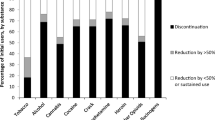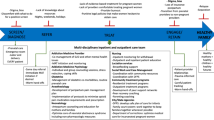Abstract
In the late-1980s and early-1990s, much attention in America was focused on cocaine abuse. In particular, the effects of prenatal cocaine use on mothers and infants were in the news spotlight. Risks of adverse effects prompted funding for novel treatment programs. More recently, media attention has shifted elsewhere, and specialized treatment resources have grown scarce. This redirection of funding is unfortunate, as social stigma and fear of legal consequences continue to encourage cocaine-abusing pregnant women to hide drug use and avoid prenatal care. The purpose of this article is to summarize the most prominent adverse maternal and fetal/infant effects associated with prenatal cocaine use; review treatment options, focusing on comprehensive care programs of the 1990s as well as recent research on evidence-based practices and their applicability to pregnant women; and highlight the population of prenatal cocaine-abusing women uninterested in treatment, with a focus on promising strategies to promote drug abstinence and other positive health behaviors.
Similar content being viewed by others
References
Papers of particular interest, published recently, have been highlighted as: • Of importance
SAMHSA OoAS: The DASIS Report: Cocaine Route of Administration Trends: 1995–2005. Rockville, MD: Substance Abuse and Mental Health Services Administration; 2007.
Blakeslee S: Crack’s toll among babies: a joyless view, even of toys. New York Times. September 17, 1989.
Kable JA, Coles CD, Lynch ME, Platzman K: Physiological responses to social and cognitive challenges in 8-year olds with a history of prenatal cocaine exposure. Dev Psychobiol 2008, 50:251–265.
Zuckerman B, Frank DA: “Crack kids”: not broken. Pediatrics 1992, 89:337–339.
Jansson LM, Svikis D, Lee J, et al.: Pregnancy and addiction. A comprehensive care model. J Subst Abuse Treat 1996, 13:321–329.
National Institute on Drug Abuse SAaMHSA: Results From the 2008 National Survey on Drug Use and Health: National Findings. Rockville, MD: National Institute on Drug Abuse; 2009.
Bandstra ES, Vogel AL, Morrow CE, et al.: Severity of prenatal cocaine exposure and child language functioning through age seven years: a longitudinal latent growth curve analysis. Subst Use Misuse 2004, 39:25–59.
Beeghly M, Martin B, Rose-Jacobs R, et al.: Prenatal cocaine exposure and children’s language functioning at 6 and 9.5 years: moderating effects of child age, birthweight, and gender. J Pediatr Psychol 2006, 31:98–115.
Birnbach DJ, Browne IM, Kim A, et al.: Identification of polysubstance abuse in the parturient. Br J Anaesth 2001, 87:488–490.
Frank DA, Zuckerman BS, Amaro H, et al.: Cocaine use during pregnancy: prevalence and correlates. Pediatrics 1988, 82:888–895.
SAMHSA SAaMHSA: Treatment Episode Data Set (TEDS): 1995–2005. National Admissions to Substance Abuse Treatment Services, DASIS Series: S-37. Rockville, MD: SAMHSA; 2007.
Haug NA, Stitzer ML, Svikis DS: Smoking during pregnancy and intention to quit: a profile of methadone-maintained women. Nicotine Tob Res 2001, 3:333–339.
Bardy AH, Seppala T, Lillsunde P, et al.: Objectively measured tobacco exposure during pregnancy: neonatal effects and relation to maternal smoking. Br J Obstet Gynaecol 1993, 100:721–726.
Haller DL, Knisely JS, Dawson KS, Schnoll SH: Perinatal substance abusers. Psychological and social characteristics. J Nerv Ment Dis 1993, 181:509–513.
Svikis D, Henningfield J, Gazaway P, et al.: Tobacco use for identifying pregnant women at risk of substance abuse. J Reprod Med 1997, 42:299–302.
Miles DR, Lanni S, Jansson L, Svikis D: Smoking and illicit drug use during pregnancy: impact on neonatal outcome. J Reprod Med 2006, 51:567–572.
Rayburn WF, Bogenschutz MP: Pharmacotherapy for pregnant women with addictions. Am J Obstet Gynecol 2004, 191:1885–1897.
Zuckerman B, Amaro H, Bauchner H, Cabral H: Depressive symptoms during pregnancy: relationship to poor health behaviors. Am J Obstet Gynecol 1989, 160:1107–1111.
Grella CE, Joshi V: Gender differences in drug treatment careers among clients in the National Drug Abuse Treatment Outcome Study. Am J Drug Alcohol Abuse 1999, 25:385–406.
Singer L, Farkas K, Kliegman R: Childhood medical and behavioral consequences of maternal cocaine use. J Pediatr Psychol 1992, 17:389–406.
Velez ML, Montoya ID, Jansson LM, et al.: Exposure to violence among substance-dependent pregnant women and their children. J Subst Abuse Treat 2006, 30:31–38.
MacGregor SN, Keith LG, Chasnoff IJ, et al.: Cocaine use during pregnancy: adverse perinatal outcome. Am J Obstet Gynecol 1987, 157:686–690.
Hintz SR, Kendrick DE, Vohr BR, et al.: Community supports after surviving extremely low-birth-weight, extremely preterm birth: special outpatient services in early childhood. Arch Pediatr Adolesc Med 2008, 162:748–755.
Mikkola K, Ritari N, Tommiska V, et al.: Neurodevelopmental outcome at 5 years of age of a national cohort of extremely low birth weight infants who were born in 1996-1997. Pediatrics 2005, 116:1391–1400.
Birnbach DJ: Substance abuse. In Obstetric Anesthesia: Principles and Practice. St. Louis, MO: Mosby; 1999:1027–1040.
Woods JR Jr, Plessinger MA: Pregnancy increases cardiovascular toxicity to cocaine. Am J Obstet Gynecol 1990, 162:529–533.
Dhopesh V, Maany I, Herring C: The relationship of cocaine to headache in polysubstance abusers. Headache 1991, 31:17–19.
Kuczkowski KM: The cocaine abusing parturient: a review of anesthetic considerations. Can J Anaesth 2004, 51:145–154.
Moore TR, Sorg J, Miller L, et al.: Hemodynamic effects of intravenous cocaine on the pregnant ewe and fetus. Am J Obstet Gynecol 1986, 155:883–888.
Ogunyemi D, Hernandez-Loera GE: The impact of antenatal cocaine use on maternal characteristics and neonatal outcomes. J Matern Fetal Neonatal Med 2004, 15:253–259.
Svikis DS, Golden AS, Huggins GR, et al.: Cost-effectiveness of treatment for drug-abusing pregnant women. Drug Alcohol Depend 1997, 45:105–113.
Treatment Center for Substance Abuse Treatment: Benefits of residential substance abuse treatment for pregnant and parenting women: highlights from a study of 50 demonstration programs of the center for substance abuse treatment. Available at http://csat.samhsa.gov/publications/residential/residential_home_toc.aspx. Accessed May 6, 2010.
• Jansson LM, Svikis DS, Velez M, et al.: The impact of managed care on drug-dependent pregnant and postpartum women and their children. Subst Use Misuse 2007, 42:961–974. This paper is pregnancy specific and discusses what worked in fee-for-service treatment programs and the effects on the mothers and drug-exposed children as these programs shifted to managed care models.
Ling W, Jacobs P, Hillhouse M, et al.: From research to the real world: buprenorphine in the decade of the Clinical Trials Network. J Subst Abuse Treat 2010, 38(Suppl 1):S53–S60.
Martino S, Brigham GS, Higgins C, et al.: Partnerships and pathways of dissemination: the National Institute on Drug Abuse-Substance Abuse and Mental Health Services Administration Blending Initiative in the Clinical Trials Network. J Subst Abuse Treat 2010, 38(Suppl 1):S31–S43.
Winhusen T, Kropp F, Babcock D, et al.: Motivational enhancement therapy to improve treatment utilization and outcome in pregnant substance users. J Subst Abuse Treat 2008, 35:161–173.
McKee SA, Carroll KM, Sinha R, et al.: Enhancing brief cognitive-behavioral therapy with motivational enhancement techniques in cocaine users. Drug Alcohol Depend 2007, 91:97–101.
Morgenstern J, Morgan TJ, McCrady BS, et al.: Manual-guided cognitive-behavioral therapy training: a promising method for disseminating empirically supported substance abuse treatments to the practice community. Psychol Addict Behav 2001, 15:83–88.
Meyers RJ, Miller WR: A Community Reinforcement Approach to Addiction Treatment. Cambridge, United Kingdom: Cambridge University Press; 2001.
Najavits LM, Weiss RD, Shaw SR, Muenz LR: “Seeking safety”: outcome of a new cognitive-behavioral psychotherapy for women with posttraumatic stress disorder and substance dependence. J Trauma Stress 1998, 11:437–456.
Miller WR, Rollnick S: Motivational Interviewing: Preparing People for Change. New York: Guilford Press; 2002.
Vasilaki EI, Hosier SG, Cox WM: The efficacy of motivational interviewing as a brief intervention for excessive drinking: a meta-analytic review. Alcohol Alcohol 2006, 41:328–335.
SAMHSA: SAMHSA website. Available at http://www.samhsa.gov/index.aspx or at http://ncadistore.samhsa.gov/catalog/. Accessed May 6, 2010.
Higgins ST, Delaney DD, Budney AJ, et al.: A behavioral approach to achieving initial cocaine abstinence. Am J Psychiatry 1991, 148:1218–1224.
Prendergast M, Podus D, Finney J, et al.: Contingency management for treatment of substance use disorders: a meta-analysis. Addiction 2006, 101:1546–1560.
Stitzer ML, Vandrey R: Contingency management: utility in the treatment of drug abuse disorders. Clin Pharmacol Ther 2008, 83:644–647.
Petry NM, Martin B: Low-cost contingency management for treating cocaine- and opioid-abusing methadone patients. J Consult Clin Psychol 2002, 70:398–405.
Stitzer ML, Petry NM, Peirce J: Motivational incentives research in the National Drug Abuse Treatment Clinical Trials Network. J Subst Abuse Treat 2010, 38(Suppl 1):S61–S69.
Elk R, Mangus L, Rhoades H, et al.: Cessation of cocaine use during pregnancy: effects of contingency management interventions on maintaining abstinence and complying with prenatal care. Addict Behav 1998, 23:57–64.
Terplan M, Lui S: Psychosocial interventions for pregnant women in outpatient illicit drug treatment programs compared to other interventions. Cochrane Database Syst Rev 2007, 4:CD006037.
SAMHSA OoAS: Results From the 2007 National Survey on Drug Use and Health (NSDUH): National Findings Series H-34. Rockville, MD: US Department of Health and Human Services; 2008.
Albright BB, Rayburn WF: Substance abuse among reproductive age women. Obstet Gynecol Clin North Am 2009, 36:891–906, xi–xii. -->
Wiechelt SA: Introduction to the special issue: international perspectives on women’s substance use. Subst Use Misuse 2008, 43:973–977.
Legal interventions during pregnancy: court-ordered medical treatments and legal penalties for potentially harmful behavior by pregnant women. JAMA 1990, 264:2663–2667.
Kandall SR: Substance and Shadow: Women and Addiction in the United States. Cambridge, MA: Harvard University Press; 1996.
English A: Prenatal drug exposure: grounds for mandatory child abuse reports. Youth Law News 1990, 11:3–8.
Personal Responsibility And Work Opportunity Reconciliation Act of 1996, Pub L No. 104-193, 110 Stat 2105; 1996.
Lester BM, Andreozzi L, Appiah L: Substance use during pregnancy: time for policy to catch up with research. Harm Reduct J 2004, 1:5.
Ondersma SJ, Simpson SM, Brestan EV, Ward M: Prenatal drug exposure and social policy: the search for an appropriate response. Child Maltreat 2000, 5:93–108.
Moyer A, Finney JW, Swearingen CE, Vergun P: Brief interventions for alcohol problems: a meta-analytic review of controlled investigations in treatment-seeking and non-treatment-seeking populations. Addiction 2002, 97:279–292.
• Apodaca TR, Longabaugh R: Mechanisms of change in motivational interviewing: a review and preliminary evaluation of the evidence. Addiction 2009, 104:705–715. This is an excellent recent review of the MI technique that investigates four constructs of therapist behavior and five constructs of client behavior to determine which constructs were most associated with better outcomes.
Hamelmann E, Vella AT, Oshiba A, et al.: Allergic airway sensitization induces T cell activation but not airway hyperresponsiveness in B cell-deficient mice. Proc Natl Acad Sci U S A 1997, 94:1350–1355.
Yarnall KS, Pollak KI, Ostbye T, et al.: Primary care: is there enough time for prevention? Am J Public Health 2003, 93:635–641.
Anderson BL, Dang EP, Floyd RL, et al.: Knowledge, opinions, and practice patterns of obstetrician-gynecologists regarding their patients’ use of alcohol. J Addict Med 2010, 4:1–8.
DePue JD, Goldstein MG, Schilling A, et al.: Dissemination of the AHCPR clinical practice guideline in community health centres. Tob Control 2002, 11:329–335.
• Ondersma SJ, Svikis DS, Schuster CR: Computer-based brief intervention: a randomized trial with postpartum women. Am J Prev Med 2007, 32:231–238. This paper highlights the translational aspects of the computer-based model and the practical utility of this approach in identifying and intervening with non–treatment-seeking pregnant women who are at risk of alcohol or drug problems.
Kay-Lambkin FJ, Baker AL, Lewin TJ, Carr VJ: Computer-based psychological treatment for comorbid depression and problematic alcohol and/or cannabis use: a randomized controlled trial of clinical efficacy. Addiction 2009, 104:378–388.
Disclosure
No potential conflicts of interest relevant to this article were reported.
Author information
Authors and Affiliations
Corresponding author
Rights and permissions
About this article
Cite this article
Hull, L., May, J., Farrell-Moore, D. et al. Treatment of Cocaine Abuse During Pregnancy: Translating Research to Clinical Practice. Curr Psychiatry Rep 12, 454–461 (2010). https://doi.org/10.1007/s11920-010-0138-2
Published:
Issue Date:
DOI: https://doi.org/10.1007/s11920-010-0138-2




